Readings:
Psalm 118:19-29
2 Chronicles 6:12-20
Ephesians 2:17-22
Matthew 7:24-29Preface for the Dedication of a Church
[Common of an Artist, Writer, or Composer]
[For Artists and Writers]
[On the Anniversary of the Dedication of a Church]
PRAYER (traditional language)
Gracious God, we offer thanks for the vision of Ralph Adams Cram, John LaFarge and Richard Upjohn, whose harmonious revival of the Gothic enriched our churches with a sacramental understanding of reality in the face of secular materialism; and we pray that we may honor thy gifts of the beauty of holiness given through them, for the glory of Jesus Christ; who livest and reignest with thee and the Holy Spirit, one God, in glory
everlasting. Amen.
PRAYER (contemporary language)
Gracious God, we thank you for the vision of Ralph Adams Cram, John LaFarge and Richard Upjohn, whose harmonious revival of the Gothic enriched our churches with a sacramental understanding of reality in the face of secular materialism; and we pray that we may honor your gifts of the beauty of holiness given through them, for the glory of Jesus Christ; who lives and reigns with you and the Holy Spirit, one God, in glory everlasting. Amen.
This commemoration appears in A Great Cloud of Witnesses.
Return to Lectionary Home Page
Webmaster: Charles Wohlers
Last updated: 17 October 2020
RALPH ADAMS CRAM, RICHARD UPJOHN, AND JOHN LAFARGE
ARCHITECTS, 1942, 1878; ARTIST, 1910
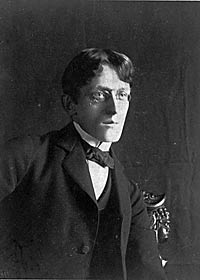 Ralph Adams Cram (December 16, 1863 - September 22, 1942), was a prolific and influential American architect of collegiate and ecclesiastical buildings, often in the Gothic style.
Ralph Adams Cram (December 16, 1863 - September 22, 1942), was a prolific and influential American architect of collegiate and ecclesiastical buildings, often in the Gothic style.
During an 1887 Christmas Eve mass in Rome, he had a dramatic conversion experience. For the rest of his life, he remained a fervent Anglo-Catholic.
A leading proponent of disciplined Gothic Revival architecture in general and Collegiate Gothic in particular, Cram is most closely associated with Princeton, where he was awarded a Doctor of Letters and served as Supervising Architect from 1907 to 1929. Through the 1920s Cram was a public figure and frequently mentioned in the press. The New York Times called him "one of the most prominent Episcopalian laymen in the country".
Cram's buildings include:- All Saints' Church, Ashmont, Massachusetts, 1892
- Church of St. John Evangelist, St. Paul, Minnesota, 1892
- Emmanuel Church, Newport, Rhode Island, 1900
- Calvary Episcopal Church, Pittsburgh, Pennsylvania, 1904
- Holy Cross Monastery, West Park, New York, with Henry Vaughan, 1904
- All Saints' Chapel, Sewanee, begun 1904, finished 1959
- Saint Thomas Church, New York City, 1905-1913
- Cathedral Church of St. Paul, Detroit, Michigan, 1908
- All Saints Cathedral, Halifax, Nova Scotia, 1910
-
Cathedral of Saint John the Divine, New York City, begun 1912, unfinished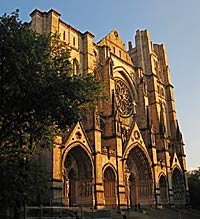
Cathedral of St. John the Divine - multiple buildings at Princeton University, Princeton, New Jersey, 1913-1927
- Cole Memorial Chapel, Wheaton College, Norton, Massachusetts, 1917
- Trinity Episcopal Church, Houston, Texas, 1919
- St. Mark's Episcopal Cathedral, Hastings, Nebraska, 1921-1929
- St. Paul's Episcopal Church, Winston-Salem, NC Winston-Salem, 1928
more at Wikipedia
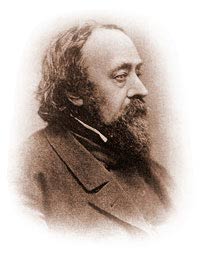 Richard Upjohn (22 January 1802 - 16 August 1878) was an English-born architect who emigrated to the United States and became most famous for his Gothic Revival churches.
Richard Upjohn (22 January 1802 - 16 August 1878) was an English-born architect who emigrated to the United States and became most famous for his Gothic Revival churches.
His family initially settled in New Bedford, Massachusetts and then moved on to Boston in 1833, where he worked in architectural design. He had relocated to New York by 1839 where he worked on alterations to Trinity Church. The alterations were later abandoned and he was commissioned to design a new church, completed in 1846. He published his extremely influential book, Upjohn's rural architecture: Designs, working drawings and specifications for a wooden church, and other rural structures, in 1852.
Notable projects included:
-
Trinity Church in New York City (1839-46)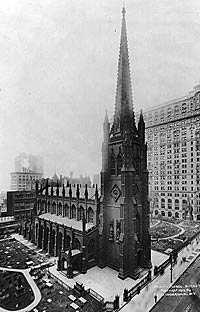
View of Trinity Church, New York, in 1912 - The Church of the Ascension in New York City (1840-41)
- Grace Church, Providence, Rhode Island (1845; later remodelled by Ralph Adams Cram, above)
- St. Mary's Episcopal Church in Burlington, New Jersey (1846-54)
- Christ Episcopal Church in Raleigh, North Carolina (1846-48)
- Grace Church in Newark, New Jersey (1847-48)
- St. Paul's Cathedral in Buffalo, New York (1849-51)
- Zion Episcopal Church in Rome, New York (1850-1851)
- St. John Chrysostom Church in Delafield, Wisconsin (1851-56)
- St. Paul's Protestant Episcopal Church in Baltimore, Maryland (1854)
- All Saint's Episcopal Church in Frederick, Maryland (1855)
- St. Mark's Episcopal Church (San Antonio, Texas) (1858)
- St. Peter's Episcopal Church in Albany, New York (1859)
- Church of the Holy Comforter in Poughkeepsie, New York (1860)
- St. Philip's Church in the Highlands in Garrison, New York (1860-61)
- St. Stephen's Episcopal Church in Providence, Rhode Island (1860-62)
- Memorial Church of St. Luke The Beloved Physician, Philadelphia, Pennsylvania (1861)
- Trinity-St. Paul's Episcopal Church (New Rochelle, New York) (1862)
- All Saint's Memorial Church in Navesink, New Jersey (1863-64)
- St. Paul's Episcopal Church in Selma, Alabama (1871-75)
more at Wikipedia
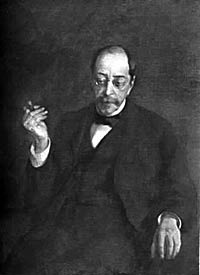 John La Farge (March 31, 1835 – November 14, 1910) was an American painter, muralist, stained glass window maker, decorator, and writer.
John La Farge (March 31, 1835 – November 14, 1910) was an American painter, muralist, stained glass window maker, decorator, and writer.
His labors in almost every type of art won for him from the French Government the Cross of the Legion of Honor and membership in the principal artistic societies of America, as well as the presidency of the National Society of Mural Painters from 1899 through 1904. Enjoying an extraordinary knowledge of languages (ancient and modern), literature, and art, by his cultured personality and reflective conversation he influenced many other people. Though naturally a questioner he venerated the traditions of religious art, and preserved always his Catholic faith and reverence.
La Farge experimented with color problems, especially in the medium of stained glass. He succeeded not only in rivaling the gorgeousness of medieval windows, but in adding new resources by his invention of opalescent glass and his original methods of superimposing and welding his material.
Among his many stained glass masterpieces are:
-
two of his largest windows, the 1887 "Angel of Help" and the 1901 "Figure of Wisdom", in Unity Church in North Easton, Massachusetts.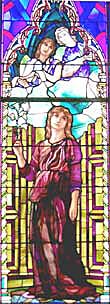
LaFarge window at the web author's former parish church, All Saints, Whitman, Mass.. - Sealing of the Twelve Tribes, Trinity Episcopal Church, Buffalo, New York, 1889
- two windows at the Thomas Crane Public Library, Quincy, Massachusetts
- 14 windows at the Judson Memorial Church, Greenwich Village, New York City
- four windows at the Trinity Church, Boston
- windows at the St. Paul's Chapel, Columbia University, NYC
- rose window at the First Unitarian Church of Philadelphia
more at Wikipedia